Content
- 1 Self-fertile varieties of cherries
- 2 Early varieties of cherries
- 3 Medium ripening cherry varieties
- 4 Late varieties of cherries
- 5 Large varieties of cherries
- 6 Low-growing (dwarf) cherry varieties
- 7 The best cherry varieties for the southern regions of Russia
- 8 The best cherry varieties for the northern regions
- 9 The most delicious cherry varieties for Siberia and the Urals
- 10 The best cherry varieties for the Moscow region, description and care
- 11 Backyard yellow
- 12 Bereket
- 13 Goryanka
- 14 Tyutchevka
- 15 Dunn
- 16 Dolores
- 17 Pridonskaya
Self-fertile cherry varieties are very profitable to grow. For their abundant fruiting, pollinators are not needed, so on the site a tree can grow in splendid isolation and at the same time give large yields. The article will describe the benefits of growing self-fertile trees, and also describe the most productive, large-fruited and low-growing varieties.
What are the features of self-fertile varieties?
It does not always make sense to plant several types of cherries or any other types of trees on the site. If the family is small, the harvest is only for personal needs, all the extra fruits will simply disappear. In such cases, it is beneficial to plant self-fertile trees. All self-fertile cherry varieties can produce large yields without any pollinators. For them, other trees are not planted nearby, and this greatly saves space on the site.
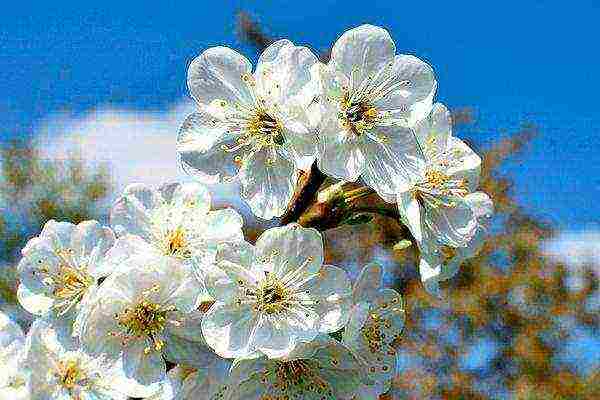 Self-fertile cherry flowers have an unusual structure
Self-fertile cherry flowers have an unusual structure
Self-fertile cherry flowers have an unusual structure. The height of the stamen with the anther and the pistil is the same. This leads to the fact that the flower is pollinated even before the bud opens. A high yield is also achieved by the fact that pollen germinates in a tree for 13-25 days at a temperature of +10 degrees and above. All this together leads to a high yield of the tree and, in some cases, to long-term fruiting.
But the productivity of such trees does not always satisfy the needs of the gardener. And here a little trick helps - the yield of self-fertile cherries can be increased by planting pollinators next to it. This is exactly what the farmers who grow berries for sale do.
Large-fruited varieties of self-fertile cherries
Self-fertile cherry varieties can be large or small berry sizes. Large-fruited varieties are more practical. It is convenient to collect berries from them, they are large, they look beautiful in jam or in compote.
- "Garland" - early variety, can be grown in server areas. Grows up to 4 meters, pruning is mandatory and regular. The crown is round, not thickened. The berries are large, average weight - 6.1 g, dense consistency, juicy, burgundy. The bone is large. The taste is sweet and sour, the acidity is expressed. In the composition up to 14% sugars and within 2% acids. Transportable, stored for a long time. Cherries are harvested up to 9-20 kg / tree, depending on the care. Frost resistance up to -35 degrees.
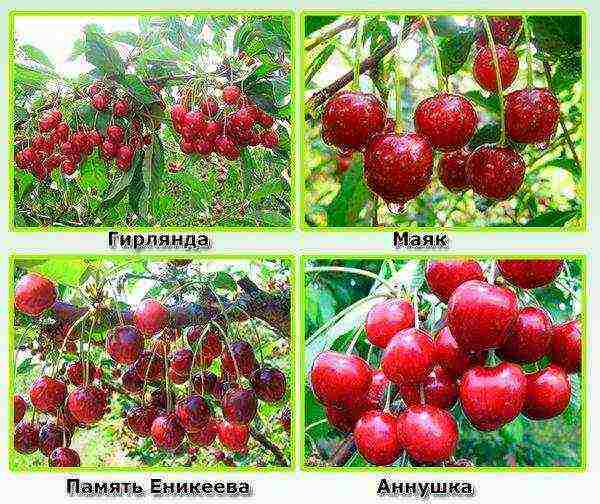 Large-fruited varieties of self-fertile cherries
Large-fruited varieties of self-fertile cherries - "Lighthouse" - bush type cherry, grows up to 2 meters, no more, the crown is large, requires a lot of space. Berries 6 g, burgundy, with a glossy shine. The taste is sweet and sour, delicate. Grown for sale and personal use, preserved and fresh. Productivity 5-15 kg / bush.
- "Memory of Yenikeev" grows up to 3 meters. The crown is not very dense, spherical. The fruits are large, reaching 5 g. The berries are elongated, claret, almost black when ripe. The pulp is juicy and tasty. The main disadvantage is a large bone.Yields yields from 3-4 years after planting the tree. The harvest ripens around the end of July. Up to 15 kg of berries are harvested from the tree.
- "Annushka" - self-fertile early ripening cherry variety, berries can be eaten by mid-June or early July. The tree does not grow very large, with an extensive crown. Cherries from 4.8 g, round. The seed is large. The peel is bright red, shiny, dense - has high transportable qualities. Fruiting from 3-4 years, yield - 107-138 c / ha.
- "Youth" - mid-early variety, ripens in the middle of summer. Cherries are harvested at 10-12 kg / tree. It grows up to 2-2.5 meters, the crown is "crying", round in shape. Berries from 4.5 g or more, elongated, burgundy, are used in any form. Dessert taste, sweet and sour. The stone is small, it separates from the pulp without any problems. The variety is not afraid of severe frosts down to -30 degrees, there is an average resistance to fungal diseases.
Description of the most productive self-fertile varieties
Harvesting trees are beneficial. They are planted for sale or if the family is large and a lot of harvest is needed. The best self-fertile cherry varieties with high yields are presented below.
- "Lyubskaya" has a not very large tree up to 2.5 meters, bushy, wide crown, spreading, but rare. Fruiting from 2 years at 12-25 kg / tree (depending on care). The berries ripen around the last month of summer. In inflorescences there are 3-4 flowers with white petals. Cherries from 4 g to 6 g, heart-shaped with a blunt tip, burgundy. The pulp is red, the juice from this species is light. Cherries are juicy, sweet and sour. It contains 9.5-10% sugars, 1.7-1.8% acids. The drupe is small, lags behind the pulp without problems. Typically grown for processing.
 The most productive self-fertile varieties of cherries
The most productive self-fertile varieties of cherries - "Cinderella" - a mid-season variety of self-fertile cherries. Berries up to 4 g, scarlet, oval, not very large. The taste is sweet and sour. It is appreciated for its frost resistance. Productivity - 15 kg / tree. The variety is frost-resistant, does not require treatment against fungal diseases.
- Apukhtinsky has an average yield of 8-12 kg / tree. Grows up to 3 meters in the form of a large shrub. Fruiting from the 2nd year after planting. Berries up to 4 g, heart-shaped, red. The bone is small. The pulp is juicy, also red, fleshy. Sour taste, bitterness may be present. They are usually used for processing. Recommended for cultivation in the southern and middle regions.
- "Volochaevka" - mid-season variety. A tree of medium height - up to 3.5 meters. Fruiting annually, 12-15 kg of cherries are removed from the tree. Berries weighing 2.7-3.7 g, sweet and sour, high in juice, red. In the composition up to 10% sugar and within 1.4% acid. The stone is small, easy to remove. Disadvantages: poor frost resistance, prone to rotting with an abundance of moisture in the ground.
- "Rossoshanskaya black" grows up to 3-4 meters in height. The crown is not thick, large, requires a lot of space. Berries up to 4.5 g, round, burgundy, almost black. The pulp is dark cherry, sweet, tasting score - 4.5 points. Sugars in the composition up to 12.3%, and acids up to 1.9%. Productivity from 6 years 15.3 kg / tree. Winter hardiness is excellent, however, the tree is often affected by diseases.
Which self-fertile cherries are undersized?
Low-growing trees or shrubs have become very popular in the last 5-10 years. They are easy to deal with: harvest, prune, spray, etc. Self-fertile cherry varieties are no exception. The following are small varieties that are easy to grow in almost any climate.
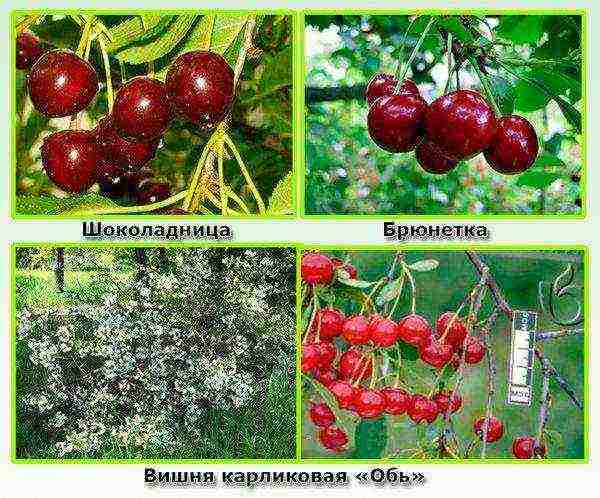 Low-growing self-fertile cherries
Low-growing self-fertile cherries
- "Shokoladnitsa" Is a self-fertile mid-early variety, the tree of which grows up to 2-2.5 meters. The crown is compact, reverse pyramidal, not very dense. The flowers are white, with about 3 flowers in the inflorescence. Berries up to 3.5 g, rounded. The color of the peel is almost black, the flesh is dark red. The stone is round, it separates well. Cherries are very tasty, sweet (sugars 12.4%, acids - 1.64%), tasting score - 4.3 points out of 5. Productivity - 77.9 c / ha.
- "Brunette" grows up to 2.5 meters, spreading crown. The berries are dark red, up to 3.8 g, maroon. The taste is sweet and sour, juicy, the pulp of a delicate consistency. The variety ripens in the 20th of July. Has a universal application. Productivity 10-12 kg / tree.
- "Ob" grows up to 1.5 m maximum. The crown is large, up to 1.6 m in diameter. Berries up to 4 g, dark red, heart-shaped with a blunt end. The pulp is light red, juicy, sweet and sour. Sugars in the composition up to 12.1%, acids - 1.4%. Recommended for processing, as it is not very tasty when fresh. The variety is mid-season, has good winter hardiness, drought resistance. Productivity up to 3.8 kg / bush. The main disadvantage is that it is often affected by coxomycosis.
VIDEO - "To help gardeners" Cherry varieties
All varieties of cherries differ among themselves in various ways, whether it is the ripening time, the size of the fruit or the region of growth. The most frost-resistant cherries are those grown in the northern regions. (Ob, Ashinskaya, Blizzard), but the most productive and sweetest varieties grow in the south of the country (Lyubskaya, Shpanka, Garland). Cherries, early ripening the most stable, but their taste is much more sour (Shokoladnitsa, Molodezhnaya), medium ripening varieties are the golden mean (Vladimirskaya, Zhukovskaya, Turgenevka). Another sign is the presence of flowers of both sexes, that is, self-fertility (Apkhutinskaya, Pamyat Yenikiev). To choose the most suitable cherry variety, you need to know all their characteristics.
Self-fertile varieties of cherries
Self-fertile varieties include cherries that no additional pollination required, and they independently set both male and female flowers.
Apukhtinskaya
A medium-sized tree on which large and tasty heart-shaped fruits grow. The Apukhtinskaya variety begins to bear fruit already in the second year after planting, refers to late ripening, the ripening of the crop falls in mid-August. The tree has good resistance to frost and drought, but it is also susceptible to fungal diseases.
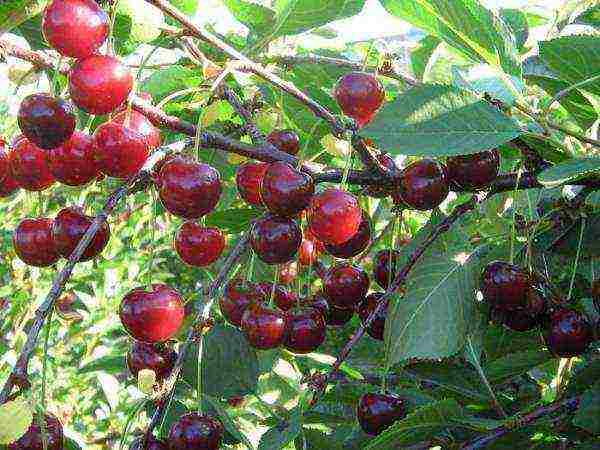 Cherry variety Apukhtinskaya
Cherry variety Apukhtinskaya
Memory of Yenikiev
The tree grows up to 3 meters in height, the crown is of medium density, spherical in shape. Fruit weight reaches 5 gramsso they can be considered large. The shape of the berries is oval, the color is dark red. Cherry pulp Yenikiev's memory is very tasty and juicy. The variety is distinguished by the presence of a large bone... The tree begins to bear fruit already at 3-4 years of age, the period of full ripening of the crop falls at the end of June. Up to 15 kilograms of fruit can be harvested from one cherry.... It has medium resistance to frost and drought.
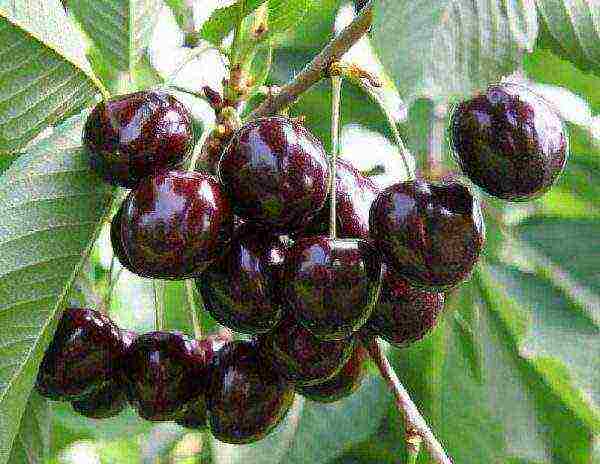 Cherry in Memory of Yenikeev
Cherry in Memory of Yenikeev
Also, self-fertile varieties of cherries include Garland, Brunette, Cinderella, Shokoladnitsa, ErdiBetermo, Ksenia, Nochka, Vstrecha, etc.
Early varieties of cherries
Cherry varieties that ripen between early June and mid-July are called early cherry varieties.... Their berries are less sweet, and the trees have good frost resistance.
Chocolate girl
This cherry tree is of medium height, with a crown shape reminiscent of an inverted cone. The berries are distinguished by their sour taste and maroon color. The pulp is a deep red shade, dense, with an easily detachable bone... The Shokoladnitsa variety tolerates frost and drought well, is resistant to many diseases, and is self-fertile. Brings a stable harvest.
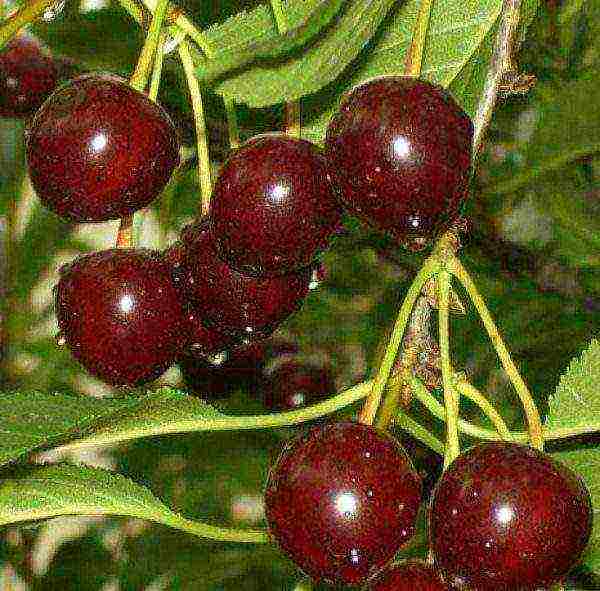 Cherry Shokoladnitsa
Cherry Shokoladnitsa
Spunk
This variety is a cherry-cherry hybrid. A tall tree with freely growing branches resembles a ball in its shape. In addition, the attachment of the branches to the tree is rather weak, therefore, when the crop appears, there is a risk that they will begin to break. The taste of berries is sweet and sour, on average, their weight is 4 grams... Fruit color is dark red, rounded-flattened shape. The first crop of Spanka brings in 6-7 years of life, but at the age of 20, you can get up to 60 kilograms of cherries from a tree. Fruiting occurs from late June to early July... The variety is highly resistant to frost and drought and needs pollinators.
 Cherry varieties Shpanka
Cherry varieties Shpanka
Youth
Shrub cherry, with a low, slightly drooping crown. The fruits of the Molodezhnaya variety are large in size, their weight can reach 4.8 grams, the skin and pulp have the same maroon color. The stone separates well, and a slight sourness is felt in the taste of the cherries themselves, such berries are perfect for preservation and freezing. The first crop appears on a 5-year-old tree, fruiting mainly occurs on last year's wood... Molodezhnaya is a frost-resistant variety. Has an average disease resistance.
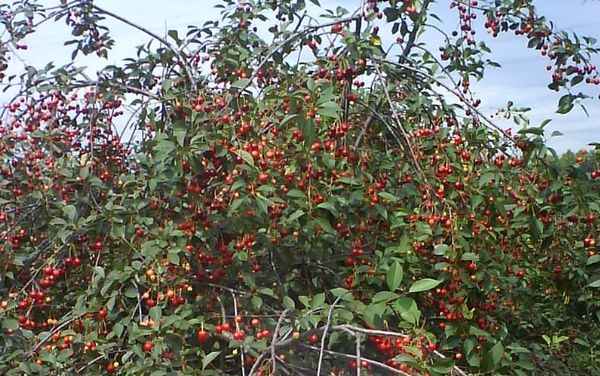 Shrub self-fertile cherry variety Molodezhnaya
Shrub self-fertile cherry variety Molodezhnaya
Miracle cherry
Arboreal cherry with medium vigor. The crown of the tree needs constant formation, with a free form of growth, it looks like a cone, and the fruits will accumulate at the very top. The taste of berries is dessert, sweet, in all their external characteristics they resemble cherries, can reach a weight of 9.5 grams. The variety is self-fertile and needs pollinators. The tree begins to bear fruit as early as 3 years of age, while bringing a large, stable harvest. You can harvest the fruits already at the beginning of June. Miracle cherry is resistant to frost and most diseases.
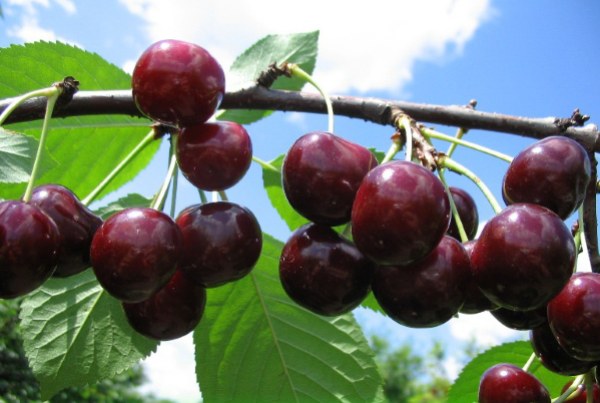 Variety Miracle cherry
Variety Miracle cherry
Baby
The tree is of medium height and spherical in shape. It bears beautiful dark red fruits with a pleasant sweet and sour taste, the stone is easily separated from the pulp. The shape of the berries is round, evenly flattened, the weight reaches 5 grams... Variety Malyshka Differs in good transportability, immunity to fungal diseases and frost resistance. Productivity is inferior to other varieties, from one tree you can get 17 kilograms of cherries. Their full maturity falls at the end of June.
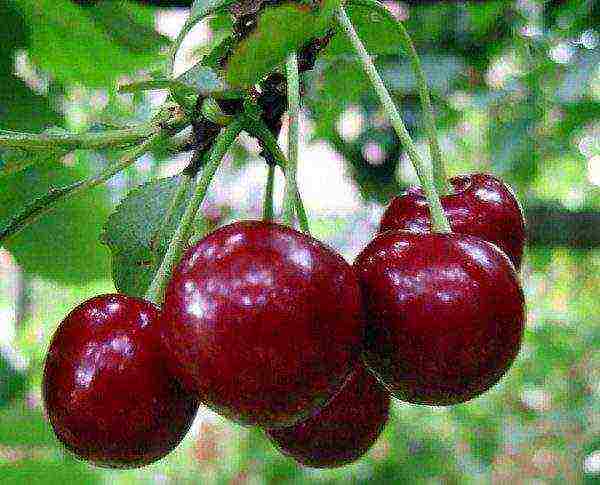 Cherry variety Baby
Cherry variety Baby
There are also other early ripening varieties of cherries. For example, Memory, Bulatnikovskaya, Enikeeva, Bagryanka, Sania, Vasilievskaya.
Medium ripening cherry varieties
Middle-early cherries are called cherries that ripen in the middle of summer, they have the best taste.
Vladimirskaya
 Cherry fruits Vladimirskaya
Cherry fruits Vladimirskaya
Vladimirskaya - one of the oldest varieties grown in the central regions of Russia. Bushy tree, grayish bark... The branches grow downward, so the shape of the crown is called weeping. 5-7 flowers of delicate white color are collected on one inflorescence. Leaves of a matte green shade, elongated, gradually sharpening towards the base and apex, the edge is double-serrate. Fruits are sweet and sour, slightly fibrous, well suited for all forms of processing. The color of the skin is dark red, almost black, the weight of the berries does not exceed 3.7 grams, the shape is round-flattened. The first fruiting occurs in the 3rd year of life., cherry ripening occurs at the end of July. This variety tolerates winter cold well, but spring frosts can completely destroy the inflorescences, and, accordingly, the entire crop. It grows best in central Russia, with good care it can bear 25 kilograms of fruit. In the northern regions, the yield drops sharply to 6-7 kilograms.... Vladimirskaya needs pollinators and additional protection from diseases and pests. If the berries are not picked in time, they will begin to crumble very quickly.
Zhukovskaya
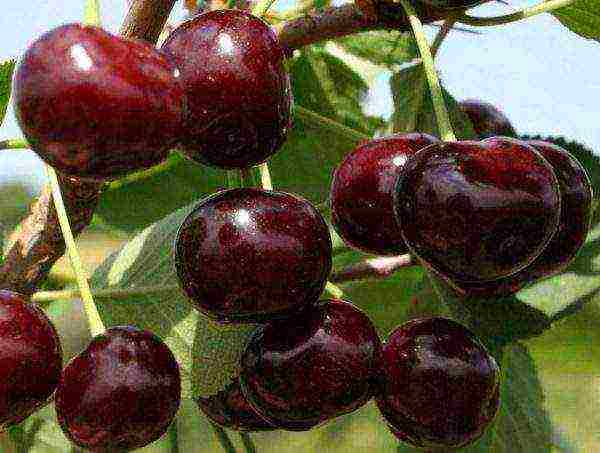 Cherry variety Zhukovskaya
Cherry variety Zhukovskaya
Cherry grows up to 2.5 meters, the crown of the tree is spreading, but rare. Leaves are narrow, oval, dark green in color. Forms inflorescences of 3-4 flowers, medium size with rounded petals. Fruiting occurs on last year's annual wood... Most often, the berries are located singly, sometimes in two. Cherry varieties Zhukovskaya medium size, up to 4 grams, dark red, heart-shaped. The pulp is tender, juicy, with a dessert taste. Disease resistance is average.
Kharitonovskaya
 Cherry variety Kharitonovskaya
Cherry variety Kharitonovskaya
The tree grows to medium size, the flowers are large, white. The berries themselves are evenly rounded, the skin is bright red, the flesh is orange. They have a sweet and sour taste, the stone is easily separated... Good immunity to various diseases, normal frost resistance. The Kharitonovskaya variety needs additional pollination.
Turgenevka
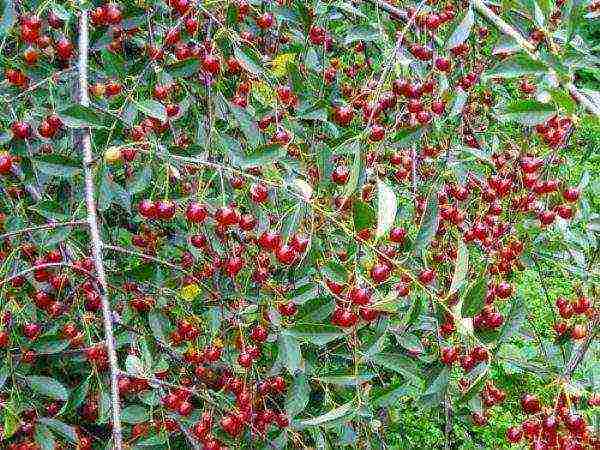 Cherry varieties Turgenevka
Cherry varieties Turgenevka
A cherry tree of this variety grows up to 3 meters, forms inflorescences of 4 white flowers. Fruiting occurs on bouquet twigs. Berries are broadly heart-shaped, large in size, weighing up to 6.5 grams... The skin color is dark red, the pulp is juicy, sour-sweet, the taste is normal. The first harvest ripens at 5-6 years of age, full ripening of fruits occurs in early July. Turgenevka tolerates winter frosts well, but may die when spring frosts appear... Possesses high resistance to diseases, requires pollinators. The variety produces a good, stable yield.
Morozovka
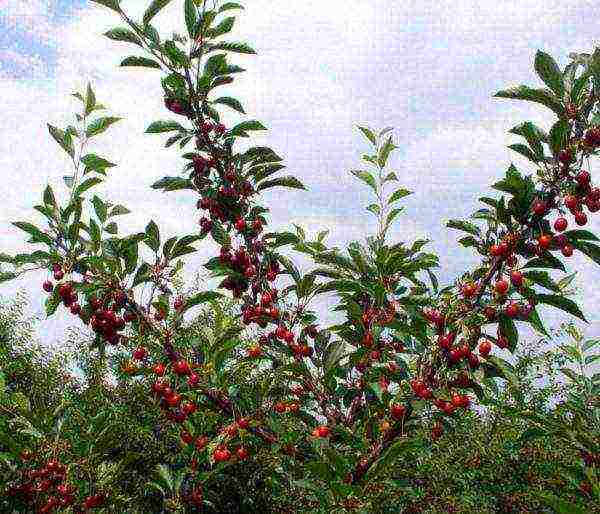 Cherry with fruits grade Morozovka
Cherry with fruits grade Morozovka
The tree grows medium in size, the crown is wide, spreading. Fruiting occurs on bouquet twigs, the berries are round in shape with a fossa at the stalk, the weight can reach 5.5 grams. The skin is dark burgundy, the pulp is juicy, dessert taste with an easily detachable bone... Such berries are suitable both for fresh consumption and for processing, they are well transported. The tree begins to bear fruit at the age of 3 years, the fruit of the Morozovka variety ripens at the end of July. The yield is stable, up to 500 kilograms per hundred square meters... The variety is resistant to frost, drought and disease. Needs pollinators.
Also, the average ripening period is possessed by the varieties Radonezh, Vstrecha, Toy, Nochka.
Late varieties of cherries
Late varieties are the last to ripen, in late summer and early autumn..
Lyubskaya
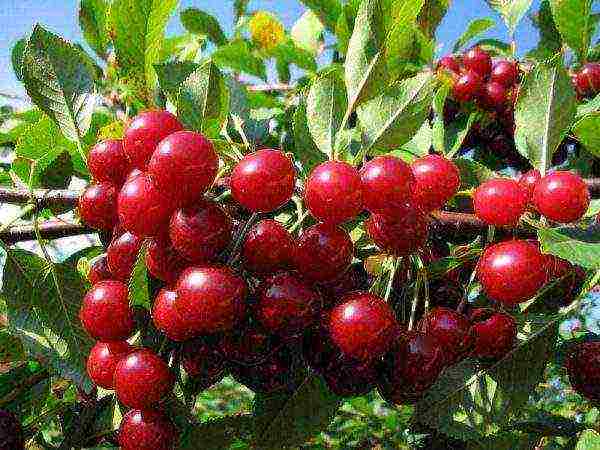 Harvest of cherries of the variety Lyubskaya
Harvest of cherries of the variety Lyubskaya
The variety is intended for cultivation in central and southern Russia, very picky about soil fertility and quality of care. Produces a large crop with blood-red, transportable fruits with a mediocre taste... These berries are ideal for processing. The tree is self-fertile, but with additional pollination it gives higher yields. A young tree bears up to 26 kilograms of fruit, and an adult up to 60. Lyubskaya does not have frost resistance, it is often exposed to various diseases.
Generous
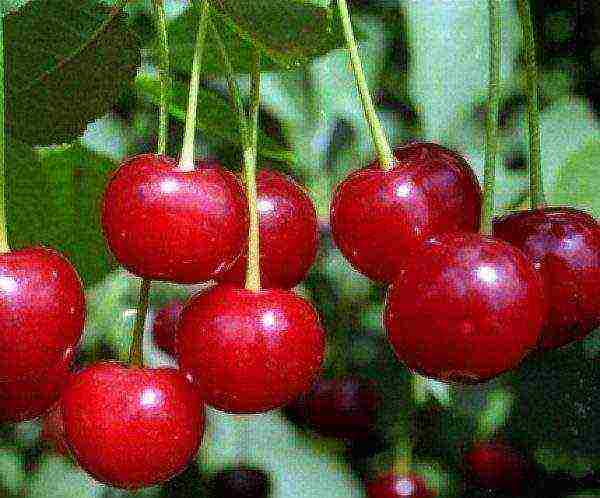 Cherry variety Generous
Cherry variety Generous
Bushy cherry with upturned shoots. The weight of one cherry is about 4 grams, its shape is round, the color is bright red. Pulp with good taste, the stone is easily separated. The presentation of the berries is at the highest level, they are resistant to cracking. Variety Generous gives an annual, bountiful harvest, ripens in autumn... The tree gives its first cherries as early as 3-4 years. Generous is distinguished by high frost resistance, can easily tolerate even spring frosts, and the variety does not lend itself to attacks by pests, and tolerates drought well. Susceptible to diseases, especially fungal diseases.
Robin
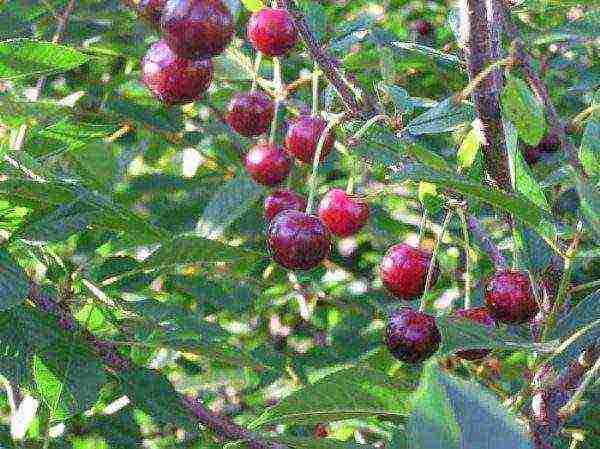 Cherry variety Malinovka
Cherry variety Malinovka
A tree of medium height with a spherical crown. Leaves with a wide plate, glossy, green, crenate edge. The cherries are small, on average, the weight of one berry is 3-3.5 grams, the shape is round... The taste is sweet and sour, pleasant, the pulp is dense. The variety gives an annual, bountiful harvest that ripens in early August. The robin needs additional pollinators and protection from disease. Frost resistance - medium.
Other varieties of late-ripening cherries are Zhuravka, Polevka, Rubinovaya, Lotovaya, Rusinka, Gorkovskaya.
Large varieties of cherries
Cherry varieties with large dessert berries are not inferior to sweet cherries in their taste. But compared to other varieties, they are whimsical to climatic conditions and quality of care.
Consumer goods Black
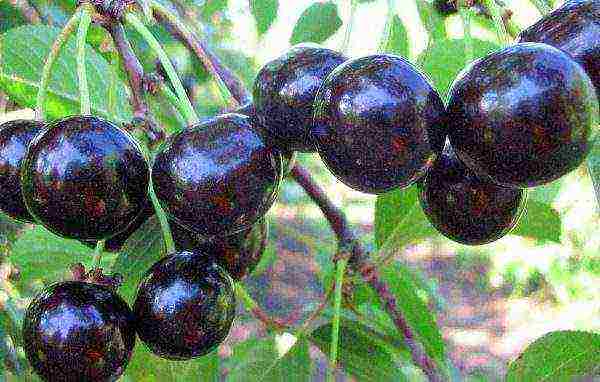 Cherry variety Consumer goods Black
Cherry variety Consumer goods Black
A low-growing tree with very tasty berries with a dark skin of almost black color.The pulp is juicy, tender, with an easily detachable bone. The fruits ripen Consumer goods Black in early June, the yield of the variety is moderate... Has a weak resistance to frost. The tree needs additional pollination.
Volochaevka
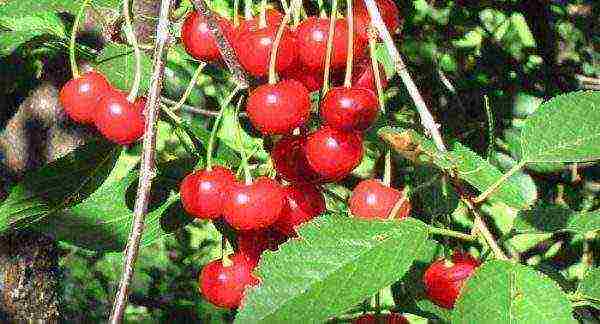 Cherry Volochaevka
Cherry Volochaevka
A medium-sized tree is capable of producing an annual harvest. The berries are sweet, juicy with firm pulp and easily removable pits. Ripens in mid-July. The variety does not tolerate frost well, in the rainy season there is a risk of rot... Volochaevka forms both female and male flowers, self-fertile.
A meeting
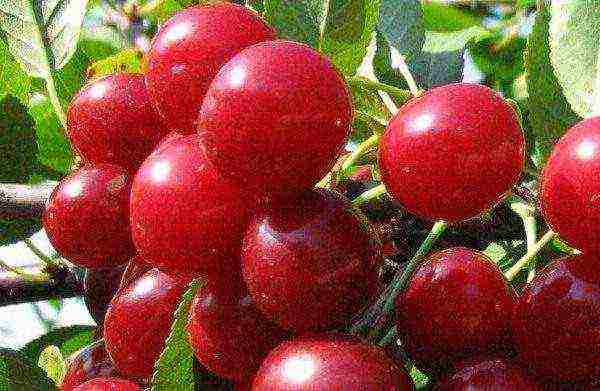 Cherry variety Meeting
Cherry variety Meeting
A low tree, the weight of the fruit of which exceeds the mark of 10 grams. The berries are bright red, with a tender and juicy pulp... The harvest of the Vetska variety is stable and annual, ripening falls on the 20th of June. The variety tolerates frost and drought well, and is resistant to fungal diseases.
Also, varieties with large fruits include Molodezhnaya, Dessertnaya Morozova, Pamyat Yenikeev, Podbelskaya, Minx, Toy, etc.
Low-growing (dwarf) cherry varieties
Trees of such varieties grow no higher than 2.5 meters.... They are very convenient for breeding and harvesting, therefore they are very popular among gardeners.
Anthracite
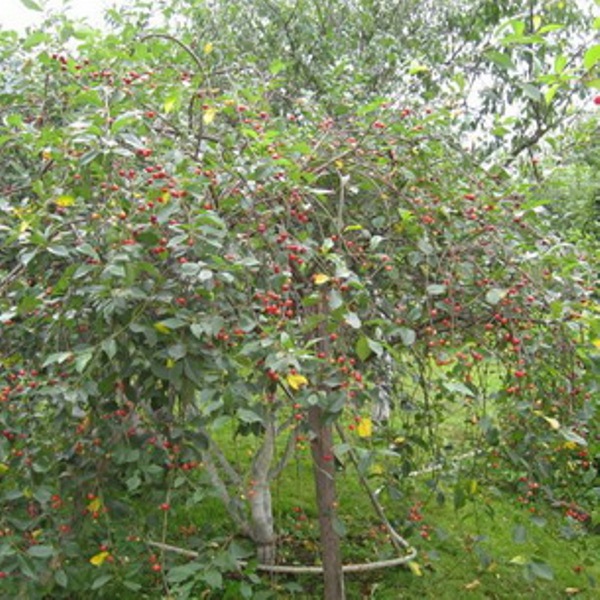 Common cherry Anthracite
Common cherry Anthracite
A bushy cherry with a wide crown, its maximum growth is 2 meters. The skin of the berries is dark, almost black in color, the pulp is blood red.... Fruit weight is 4-5 grams, taste is good. Cherries ripen in mid-summer and are well transported. The Anthracite variety is resistant to frost, drought and fungus.
Bystrinka
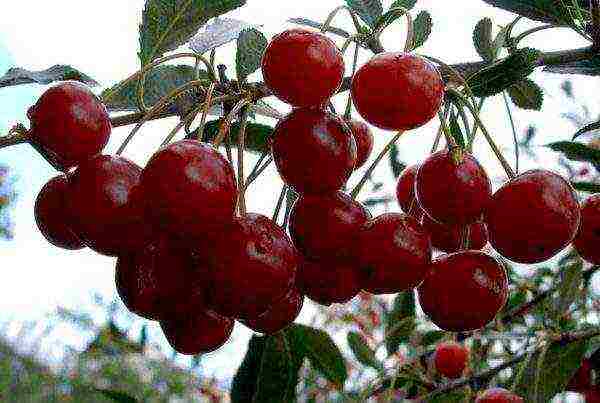 Low-growing cherry variety Bystrinka
Low-growing cherry variety Bystrinka
The small tree forms a spherical crown. Burgundy berries, with the same color pulp, their weight ranges from 3.5-4.2 grams, well transported. The taste is sweet and sour. The harvest period is early July... The resistance of the Bystrinka variety to frost is average. There is a risk of damage from moniliosis.
Mtsenskaya
 Cherry grade Mtsenskaya
Cherry grade Mtsenskaya
The tree rarely exceeds 2 meters in height, the crown is oval. Average, one berry weighs 4 grams, skin color is maroon... Most often, the fruits of the Mtsenskaya variety are processed. The trees are characterized by good resistance to frost, drought and most diseases. They also have an attractive appearance, which is why they are often used in landscape design.
There are many undersized varieties of cherries, these include Lyubskaya, Molodezhnaya, Memory Mashkin, Shokoladnitsa, Vladimirskaya, Tamaris and Saratov baby.
The best cherry varieties for the southern regions of Russia
Such varieties are distinguished by excellent taste, low or medium frost resistance. Their cultivation is possible only in warm climatic conditions.
Sasha
On average, the tree grows up to 3-4 meters, the foliage is average. Fruiting occurs on annual shoots. The fruits are large, juicy, red. They are distinguished by excellent taste. The Sasha variety is frost-resistant, rarely exposed to diseases.... The first fruiting occurs in the 5th year of life, early ripening.
Garland
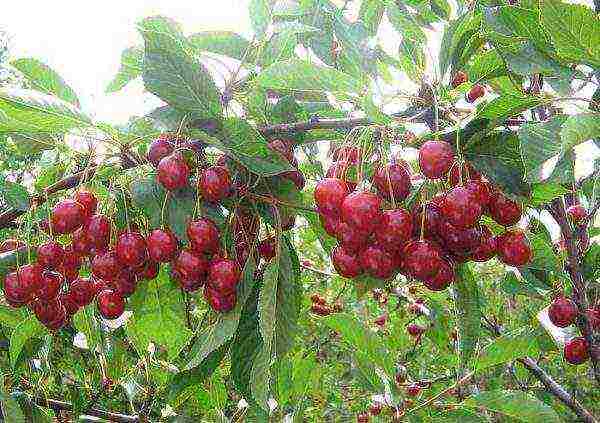 Cherry variety Garland
Cherry variety Garland
The growth of the tree is 3 meters, a large amount of foliage is formed on the branches. The Garland variety is distinguished by the presence of inflorescences, of which 5 fruits appear. The berries are very large, juicy and tasty, the skin color is slightly darker than the flesh. The first crop can be harvested in mid-June as early as the 3rd year of life... The tree does not need additional pollination.
Also, for the southern regions, varieties such as Lyubskaya, Shpanka, Shokoladnitsa are suitable.
The best cherry varieties for the northern regions
Ashinskaya
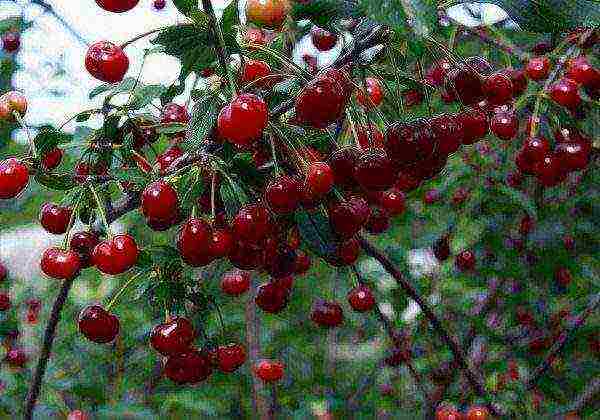 Cherry grade Ashinskaya
Cherry grade Ashinskaya
It is considered the best variety for the northern regions. A low-growing shrub, whose growth does not exceed 1.5 meters, can tolerate frosts down to -55 degrees... Also drought tolerant. Berries are dark in color, with dense pulp, slightly astringent, sweet and sour taste.The bone is small, easy to remove. Flowering occurs from the beginning of April, the shrub gives its first harvest at 4 years of age.
Ob
 Cherry Ob
Cherry Ob
A short shrub that is only 130 centimeters tall. Fruiting occurs on annual growths. Berries are small, dark red in color, with a good taste and a small, well-separated seed... Fruits ripen in mid-July. The Ob is capable of withstanding severe frosts and drought, but is highly susceptible to pest attacks. The variety is self-fertile and does not need pollination.
Altai swallow
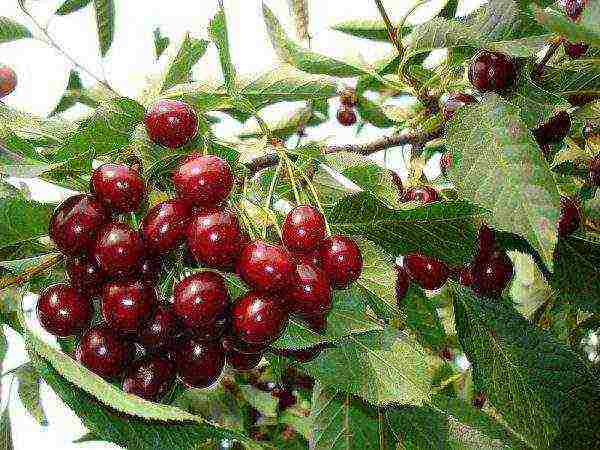 Cherry variety Altai swallow
Cherry variety Altai swallow
A low-growing bush, no more than 150 centimeters high. The berries are round in shape and medium in size, distinguished by excellent taste and juiciness... Fruit ripening occurs in mid-July. The yield of the variety is very different from the trees growing in the southern regions, and is only 5 kilograms. The Altai swallow tolerates frost and drought well, and is immune to many diseases. It is also a pollinator for many cherry varieties.
For the northern regions, the Novoaltaiskaya and Metelitsa varieties may be suitable.
The most delicious cherry varieties for Siberia and the Urals
Such varieties of cherries adapt well to the changeable climate of Siberia and the Urals, besides, they are distinguished by good yield and taste.
Ural ruby
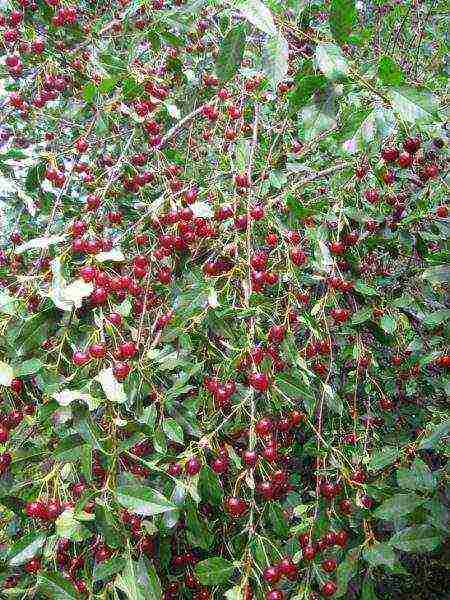 Cherry shrub Ural ruby
Cherry shrub Ural ruby
A shrub, whose growth is 1.5 meters, the crown is wide, the branches are weeping, growing downward. The leaves are wide, shiny, dark green in color, their shape resembles a boat. Fruits weigh only 3-4 grams, round in shape, dark red, juicy, sweet and sour taste... Ripen in mid-August. The variety is self-fertile, but it has a stable and good yield; an adult tree bears up to 10 kilograms of berries.
Lighthouse
 Siberian cherry variety Mayak
Siberian cherry variety Mayak
Lighthouse - a bush 2 meters high with a wide spreading crown and leaves folded into a boat. The Siberian variety is self-fertile, but when planted next to such varieties as Vole and Schedra, it gives the most abundant yields. Fruits gain weight up to 6 grams, dark red, sour-sweet taste. The crop can be harvested in early August, on average, one bush gives from 5 to 15 kilograms of fruit.
Also for these territories, the varieties Standard Ural, Schedra, Sverdlovchanka, Zagrebinskaya and Gridnevskaya are suitable.
The best cherry varieties for the Moscow region, description and care
The varieties that are best suited for the Moscow region must have good resistance to frost, and be unpretentious to the composition of the soil, a description of which can be found below.
Early varieties
From the category of early varieties of the Moscow region the varieties Molodezhnaya and Chudo cherry are best suited.
Among the mid-season varieties, one can distinguish Turgenevka, Excellent Venyaminova and Griot Moskovsky.
Griot of Moscow
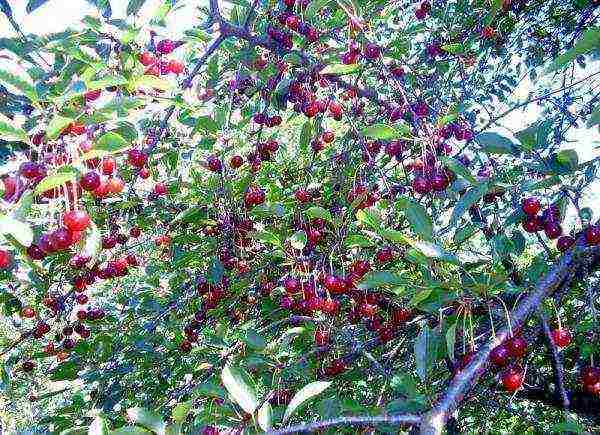 Cherry for Moscow region Griot Moskovsky
Cherry for Moscow region Griot Moskovsky
A tree with a spherical crown and matte leaves. Berries reach 3.5 grams in their weight, taste characteristics are at the highest level, fruits are suitable for various types of processing... Such a variety ripens in mid-July, the yield is above average, from a hundred square meters you can get up to a ton of cherries. Resistance to winter cold and return frost is excellent. Undergoes coccomycosis and monial burn.
Late varieties
Among the varieties of late ripening Zhukovskaya has recommended herself in the best way.
The undersized (dwarf) cherry varieties for the Moscow region include Molodezhnaya, Mayak, Tamaris, Bystrinka, Memory Mashkin and Malyshka.
Tamaris
The crown of the tree is small, rounded. Fruits are dark red in color with sparse brown spots. The pulp of the berries is juicy, the taste is sour. Cherries can be used both for fresh consumption and for various processing, the transportability of the fruits is average. You can harvest the crop in early August. The variety has good frost and drought resistance.
In memory of Mashkin
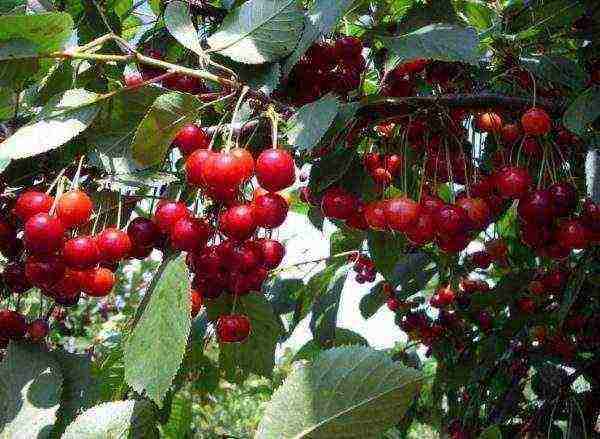 Cherry variety in Memory of Mashkin
Cherry variety in Memory of Mashkin
The crown of the tree is spreading, drooping, spherical in shape. The fruits are large in size, grow up to 5 grams, with their own dessert taste, they often become a decoration of any garden. Maturation occurs in mid-July... Resistance to frost and sore immunity is average.
Self-fertile varieties
The most popular self-fertile varieties for the Moscow region are Apukhtinskaya, Lyubskaya, Zagorievskaya, Volochaevka, Shokoladnitsa, Vstrecha, Garland and Cinderella.
Cinderella
Medium-sized tree, forming fruits weighing 4 grams, rounded oval and light red in color, sweet and sour taste. The harvest ripens in mid-July, from one tree you can get up to 15 kilograms of berries... The frost resistance of the tree itself and of the flower buds is excellent. The variety does not require additional protection against fungal diseases.
Breeders have bred a huge number of cherry varieties, which makes it possible to grow this crop in all corners of Russia. For the most part, all trees have good to medium frost resistance and bear sweet and sour fruits.... Each gardener can choose and plant the cherry that will decorate his particular plot.
If you cannot boast of a large plot, then when choosing a cherry variety for yourself, you should focus not only on its characteristics (yield, fruit weight, taste, resistance to pests and diseases), but also on its self-fertility.
Self-fertility is the ability of trees to bear fruit without cross-pollination with other tree varieties. Self-fertile cherry varieties will have to be selected by those gardeners who own small plots and are not able to place several varieties blooming at the same time on them for mutual cross-pollination. Unfortunately, not so many varieties are capable of self-pollination.
We have selected the top 7 best self-fertile cherry varieties and ranked them in descending order of self-fertility (from the highest to the lowest value of this indicator). All these varieties will surely delight you with a decent harvest, even far from the "sister" trees.
It is important to understand that the yield of inter-pollinated cherry trees will always be higher than that of self-pollinated plants. This is a specific feature of the culture - in order to obtain the maximum yield variety declared in the description, the sweet cherry needs pollinating varieties.
Backyard yellow
This variety is the leader of our top, as it has the highest self-fertility among the known varieties of sweet cherry. Due to the fact that the size of the tree is medium, and the fruits are tasty and fragrant, the Home Garden is always a welcome guest on any, even a small garden plot.
The yellow color of the fruit will add charm and charm to the garden, decorate the table and diversify the gardener's diet. You won't have to wait long for fruits - trees quickly enter fruiting, are characterized by active growth and high resistance to both diseases and pests, as well as to winter frosts, and even spring frosts.
Sweet cherries of this variety will always provide you with a harvest, because its fruits hang on branches without crumbling or cracking even in rainy weather.
| Entering fruiting | Tree height (m) | Fruit weight (g) | Harvest | Pollinating varieties |
| For 5-6 years | 3,5-4,5 | 5,0-5,5 | Early July | Does not need pollinating varieties |
Bereket
This variety has a high self-fertility, however, to increase the yield, one or a couple of pollinator varieties can be planted with it. The variety was obtained at the very beginning of the XXI century, and therefore is characterized by all the characteristics inherent in modern varieties - high winter hardiness and drought resistance, as well as resistance to pests and diseases.
The trees of the Bereket variety are medium in size, they are suitable for any, even the most modest site. Plants quickly bear fruit and produce beautiful dark red fruits with juicy, surprisingly tasty pulp.
The undoubted advantages of the variety include the high transportability of the fruit, and the absence of the need for formative pruning of the tree, which makes it simply ideal for planting in the country.
| Entering fruiting | Tree height (m) | Fruit weight (g) | Harvest | Pollinating varieties |
| For 4-5 years | 4,8-5,3 | 5,6-6,3 | Start - mid June |
Self-fertile, but when pollinated varieties Iput and Revna the harvest increases |
Goryanka
The variety was bred in the last century, but this does not mean that it is morally obsolete. It will give odds to any, even the most modern cultivator, because its trees have restrained growth, resistance to drought and frost, as well as diseases and pests.
The fruits of this variety are quickly tied after flowering and ripen together, turning into elegant maroon "dresses" with a pleasant, juicy and very tasty pulp.
The variety is remarkable in that it gives good yields, even a single tree is planted on the site. The fruits can be transported over long distances without damage, and the seed in the berries is small and separates very well from the pulp.
The variety is suitable for cultivation in summer cottages and small farms.
|
|
||||
| Entering fruiting | Tree height (m) | Fruit weight (g) | Harvest | Pollinating varieties |
| For 4-5 years | 4,1-4,7 | 6,0-6,4 |
Start - |
Self-fertile, but when pollinated varieties Iput and Revna the harvest increases |
Tyutchevka
A modern cherry variety with a whole complex of useful and necessary signs for any summer resident is both sufficient self-fertility, and the modest size of the tree, and resistance to diseases, pests, frost and drought, as well as early entry into the season of fruiting and, of course, excellent taste and fruit color, which is good in compote, and fresh when full of sweet juice.
The fruits have a bizarre wide-rounded shape, a dark red "outfit" pleasant to the eye and surprisingly juicy, tasty red pulp.
The variety can be advised to plant on your site also because its fruits are very pleasant to collect. The thing is that their stalk is thick and rather long, and the berries themselves break away from it easily, almost without effort, and the ripe ones hang on the branches without falling, as if waiting for you.
Due to the fact that the fruits are well transported, you can easily take them from the dacha to the house.
| Entering fruiting | Tree height (m) | Fruit weight (g) | Harvest | Pollinating varieties |
| For 4-5 years | 4,0-4,3 | 5,3-7,4 | End of June - early July |
Self-fertile, but when pollinated by varieties Ostuzhenka or Raditsa the harvest increases |
Dunn
A rare variety that can boast a complete lack of flaws, Dunn is one of them. The trees stand out among others for their luxurious pyramidal crown, which practically does not thicken and requires only sanitary pruning, for its highest resistance to winter frosts and spring frosts, as well as to pests and diseases.
It is worth planting at least one seedling of the Dunn variety on your site, as soon you will get a good harvest of large and aligned, like a ruler, fruits of a pleasant dark red color. And their flesh will be juicy, tender and so pleasant to the taste that you will eat all the berries unnoticed.
| Entering fruiting | Tree height (m) | Fruit weight (g) | Harvest | Pollinating varieties |
| For 4-5 years | 4,0- 4,7 | 4,5-4,9 | Start - mid June |
Self-fertile, but when pollinated varieties Iput and Revna the harvest increases |
Dolores
A variety with a romantic name that will not leave anyone indifferent. It will be useful to hurry gardeners who are not used to waiting for a long harvest, those who do not want to use a stepladder to pick every last berry, and those who wish to see healthy and luxuriantly blooming plants when they come to the dacha or return to the garden in spring.
Those with a sweet tooth will not be disappointed either - Dolores fruits have all the qualities to satisfy the taste of even the most fastidious cherry lover.Each fruit, like a fresh candy, is “packed” in a maroon wrapper and contains a small, almost invisible bone, which is hidden in a juicy, tasty and fragrant burgundy pulp with a piquant sourness, which does not spoil at all, but on the contrary, gives the taste sophistication.
The fruits are suitable for all types of processing, and the trees are suitable for planting in any, even the smallest area.
| Entering fruiting | Tree height (m) | Fruit weight (g) | Harvest | Pollinating varieties |
| For 4-5 years | 3,5-3,8 | 5,5-6,2 | Mid june | Self-fertile, but when pollinated varieties Iput and Revna the harvest increases |
Pridonskaya
This variety closes our top-7. But do not think that he does not have sufficient self-fertility to produce crops, even if you have a single tree growing on your site. It's not like that at all. Despite the partial self-fertility, the Pridonskaya cherry will supply you with a harvest in the form of very large, one-dimensional fruits of a rich bright red color with pink, slightly gristly and very juicy pulp of a pleasant, refreshing sweet and sour taste.
The variety is also valuable because its yield is stable and annual, because the flowers are not afraid of spring frosts, and the plant itself is not afraid of severe frosts and summer heat.
The variety is suitable for growing both in the country and in an average-sized garden, its trees do not require any pruning except sanitary, and no protection, because they do not get sick and are extremely rarely affected by pests.
| Entering fruiting | Tree height (m) | Fruit weight (g) | Harvest | Pollinating varieties |
| For 5-6 years | 3,8-4,5 | 5,0-6,5 | Start - mid June |
Self-fertile, but when pollinated varieties Iput and Revna the harvest increases |
We have considered the most interesting varieties of cherries that deserve the attention of both amateur gardeners and professionals. The listed varieties have all the features inherent in modern varieties and, moreover, are characterized by high self-fertility, which will allow you to grow on the site not only cherries, but also plants of other breeds. Do not forget that planting trees of self-fertile varieties, like other stone fruits, is best in spring.
.
In small gardens, every square meter of land is of great value, therefore, seedlings of fruit crops are selected by the gardener in advance, taking into account the dimensions of the plant. Having decided to grow cherries, you need to pay attention to self-pollinated plants, which are self-fertile varieties of cherries.
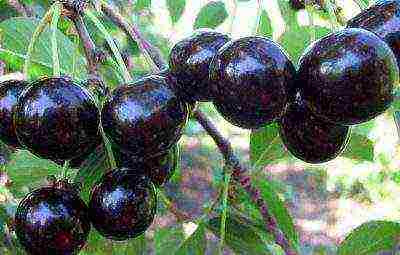
Varietal specificity
If the gardener is not chasing record harvest indicators and seeks to get berries only for the needs of his own family, he should pay attention to the varieties of self-fertile cherries. Their feature is self-pollination, that is, cherry trees do not require pollinating plants, and planting such a seedling will save space on the site and get a good harvest.
Self-fertile cherry in comparison with self-fertile plants has some differences in the structure of the flower. The stamen with the anther, as well as the pistil, are at the same level. The pollination process takes place even before the opening of the bud. Another fact: self-pollination can occur at temperatures from 100 ° C.
Most of the known self-fertile varieties are partially self-fertile. When planting a number of pollinating trees, the yield of cherry trees is significantly increased, which allows gardeners to sell excess berries.
Basic types
The absence of the need for cross-pollination gives the gardener the opportunity to plant just one tree on his site and get a rich harvest. Trees are unpretentious to care for and have good immunity to diseases and pests. Even a beginner can grow a cherry tree and get a good harvest.
It remains only to choose the variety that is suitable for planting on your site. All varieties of self-fertile cherries can be divided into 3 types:
- undersized;
- large-fruited;
- winter hardy.
Low-growing varieties are in the form of bushes, up to 3 m in height. Their productivity is low, but the berries have a pleasant sweet and sour taste.Large-fruited plants are called plants that give berries weighing from 6 g. Winter-hardy thrive in temperate and cool climates.
Large-fruited varieties
The size of the berries matters. Large berries are easier to pick, process, they look beautiful in jars with compote. Among gardeners, the most popular varieties of self-fertile cherries that produce large berries are:
- Garland. The tree reaches 4 m in height. The berries are juicy, burgundy in color. Weight from 9 to 20 g. The plant has good frost resistance (up to -350 ° C).
- Lighthouse. It grows as a bush, up to 2.5 m in height. The berries are claret, sweet and sour, weight 6–10 g. Productivity - up to 15 kg per bush.
- Youth. A medium early variety that yields up to 12 kg of berries from one tree. Fruits are juicy, red, rounded. Berry weight from 6 g.
- A meeting. The tree is low, up to 3 m in height, with a dense crown. The berries are sweet and sour, weighing 15–20 g. The variety is very popular, since it has a high yield. Up to 20 kg of berries can be harvested from one tree. The plant is resistant to both frost and drought, rarely affected by diseases and pests.
Low-growing varieties
Growing low-growing trees is popular for its easy maintenance. Such plants are convenient for watering, pruning, spraying, etc. They take up little space in the garden, tolerate temperature changes well and give a stable good harvest.
There are many self-fertile undersized cherry varieties. The most popular are:
- Ob. A miniature shrub plant that does not grow above 1.5 m. Fruits are heart-shaped, red. The taste is sweet and sour. Designed for recycling. The disadvantage is poor immunity to diseases and parasites.
- Chocolate girl. A low-growing bush with a spreading crown. It can grow up to 2 m. Its advantage is the taste characteristics of the fruit. The berries of this cherry are sweet and juicy. Their shape is rounded, brown color.
- Brunette. It grows as a bush with a spreading crown. Plant height can reach 2.5 m. Berries are 5-5.5 g, round, bright red. Due to the sour taste, they are rarely consumed fresh. The plant's advantages are resistance to weather conditions and garden diseases.
- Anthracite. The bush reaches 2.5 m in height. Differs in good resistance to frost, diseases and pests. Fruits are round, brown, weighing 5–6 g. Sweet and sour taste.
Some trees are decorative. Among such gardeners, the Mtsenskaya cherry deserves special attention. It is a low-growing variety that rarely grows more than 2.5 m. It has a beautiful oval crown and is resistant to both frost and drought. Such plants are often used in landscape design.

Winter hardy varieties
Self-fertile cherry varieties can be successfully grown in temperate and cool climates. The main criterion for success is the winter hardiness of the plant. The tree chosen for planting should not be afraid of temperature changes and is pollinated even in cool weather. When choosing a seedling for planting in the northern regions, attention should be paid to the following varieties:
- Vladimirskaya (partially self-fertile). The plant is medium-sized (up to 4 m in height). The berries are sweet, suitable for fresh consumption. During the season, 5-10 kg can be harvested from one tree.
- Novodvorskaya. The peculiarity is the pleasant sour taste of the berries. It perfectly tolerates temperature extremes, but has a tendency to become infected with coccomycosis.
- Wreath. A frost-resistant undersized variety with large fruits and small bones. Productivity - 5-10 kg (in the northern regions, the indicator is unstable). Trees are characterized by low resistance to fungal diseases.
- Star. Partially self-fertile culture (can be pollinated by cherries) with excellent taste characteristics of the fruit. The berries are juicy, sweet and sour. Productivity - 10-15 kg.
- Vavilov. Refers to partially self-fertile crops, has excellent yield and resistance to garden diseases.
- Dawn of the Volga region. The size of the tree is medium. Productivity - 5-10 kg per tree. The fruits are juicy, pink.The pulp separates well from the stone.
- Glubokskaya. Differs in high productivity and good immunity to diseases. Up to 15 kg of large juicy sweet and sour berries can be harvested from one tree.
- Lyubskaya. Differs in high self-fertility. Rounded berries, sweet and sour. Average yield - 8-10 kg. Plants are susceptible to garden pests.
When planting a plant in a suburban area, attention should be paid not only to the winter hardiness of the culture, but also to its simplicity in care. Some of the best options are Cinderella and Griot Moskovsky. They have good immunity to diseases, do not require frequent watering and give a high-quality healthy harvest of up to 15 kg per tree.
The most productive varieties
Productivity always remains one of the main criteria for choosing a seedling of a self-fertile culture. The cultivation of such plants will satisfy all the needs of the gardener in storing supplies for the winter, for sale, etc. The most popular of the high-yielding cherries are:
- Lyubskaya. It can grow both in the form of a bush and in the form of a tree. Plant height can reach 3 m. Its crown is spreading, not thickened. The fruits are round, burgundy. The mass of berries is 4–6 g. The pulp is juicy, pink, well separated from the stone. The taste is sweet and sour. It is rarely consumed fresh.
- Apukhtinsky. Grows in shrubs up to 3 m in height. Productivity - 8-10 kg per bush. Can bear fruit from the second year of life. The berries are small, heart-shaped, and have a red color. Sour taste with distinct bitterness. The fruits are more often used for processing.
- Volochaevka. Grows up to 3.5 m in height. Productivity - 12-15 kg per tree. The berries are juicy, sweet and sour. Their weight is small, up to 4 g. They are distinguished by their versatility. The only drawbacks of the variety are poor frost resistance and the tendency of the fruit to rot when the soil moisture rises.
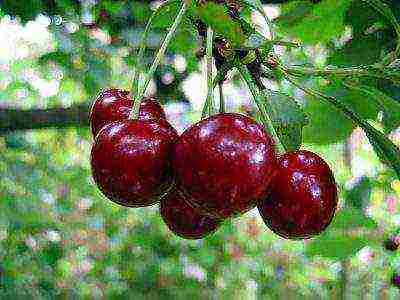
Black Rossoshanskaya cherry is especially popular. Tall tree, up to 4 m in height. The crown is spreading, dense. Berries are black, juicy, weighing 4-4.5 g. The taste is sweet, with a slight sourness. It can yield up to 16 kg of yield from one tree annually. The variety is characterized by low disease resistance.
Conclusion
The cultivation of self-fertile cherry varieties has many features, the main of which is self-pollination. There is no need to plant pollinating plants on the site. The most popular are the high-yielding varieties Cinderella, Apukhtinsky and Volochaevka.
For growing crops in the middle or northern lane, winter-hardy varieties should be preferred. The most popular are the cherries of the varieties Vladimirskaya, Novodvorskaya, Vavilova, etc.
Subscribe Be aware of new products on our site


